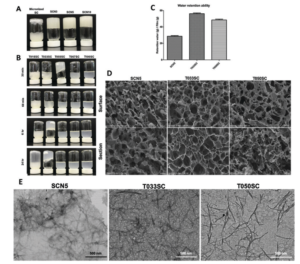Cellulose nanofibers (CNFs) are used in large amounts in the paper and biomedical industry. The synthesis process, the nature of the catalyst used, and the recyclability of the catalyst has a direct impact on the cost effectiveness of industrial grade CNFs. CNF production follows carboxylation of the primary alcohol groups at the surface of the cellulose fibres mediated by catalyst 2,2,6,6-tetramethyl-1-piperidine-N-oxy radicals (TEMPO). The genotoxic nature of TEMPO suggests the requirement of a lower concentration of the catalyst used during the reaction.
 Scheme for different synthesis strategies and characterization of TEMPO mediated CNFs.
Scheme for different synthesis strategies and characterization of TEMPO mediated CNFs.
Researchers across the world tried a green synthetic approach for CNFs preparation. This also includes successful removal of the catalyst from the product after completion of the reaction. One of the processes employs oxidation of wood pulp fibres using the magnetically recoverable Karimi’s catalyst (TEMPO@SiO2@Fe3O4). The products obtained using the modified catalyst is 5 nm thick cellulose nanofibrils like those obtained in the oxidation mediated by TEMPO in solution. Whereas, the catalyst was easily recovered with a magnet and successfully reused in 4 successive reaction cycles.
Differently modulated TEMPO like SiliaCat TEMPO (a commercial immobilized TEMPO catalyst) and others, show that hybrid sol–gel catalyst allows the synthesis of insoluble polysaccharide nanofibers of superior quality, eliminating waste.
New production strategies involve TEMPO-mediated oxidation followed by homogenisation. The residual hypochlorite can be quenched with 0.3% ascorbic acid to produce chloride and subsequently CNF is separated from the solid catalyst via simple filtration. This dramatically reduced the polysaccharide nanofiber production costs opening the route to large-scale production of functional products where their use has been limited by high cost.
For details: please visit https://pubs.rsc.org/en/content/articlelanding/2021/sc/d1sc03114g
About the blogger:
Dr. Damayanti Bagchi is a postdoctoral researcher in Irene Chen’s lab at University of California, Los Angeles, United States. She has obtained her PhD in Physical Chemistry from Satyendra Nath Bose National Centre for Basic Sciences, India. Her research is focused on spectroscopic studies of nano-biomaterials. She is interested in exploring light enabled therapeutics. She enjoys travelling and experimenting with various cuisines.
You can find her on Twitter at @DamayantiBagchi.











